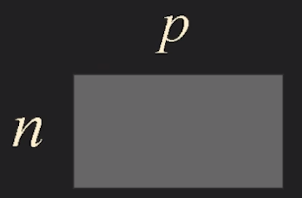Theorem 7. Characterization of Linearly Dependent Sets
An indexed set S={v1,⋯,vp} of two or more is vectors is linearly dependent, if and only if at least one of the vectors in S is a linear combination of the others.
if and only if 이므로 필요충분조건이다. 먼저, 전건에서 후건 방향을 생각해보자
S={v1,⋯,vp} 가 linearly dependent 하므로,
weight {c1,⋯,cp}에 대해서 c1v1+c2v2+⋯+cpvp=0 은 non trivial solution을 갖는다.
이때 weight 중 최소한 하나는 non zero이고, non zero 에 해당하는 weight 를 c1 이라고 가정하자. 그렇다면 v1=(−c2/c1)v2+⋯+(−cp/c1)vp 가 되므로, 후건의 꼴이 된다.
후건에서 전건 방향으로 생각해보자.
v1=c2v2+⋯+cpvp 꼴의 linear combination 이 있다
즉, −v1+c2v2+⋯+cpvp=0 꼴로 바꿀 수 있는데, 이때는 c2 부터 cp 까지 모든 coefficient 가 0이어도, v1의 coefficient 가 -1이므로 non trivial 하다. 따라서 linearly dependent 하다
Theorem7 의 뒷부분은 다음과 같다.
In fact, if S is linearly dependent and v1=0, then some vj (with j>1) is a linear combination of the preceding vectors, v1,⋯,vj−1
(some = 어떤)
c1v1+c2v2+⋯+cpvp=0 꼴을 생각해보자
j : the largest subscript for which cj=0 라고 하면
c1v1+⋯+cjvj+0vj+1+⋯+0vp=0 꼴이 된다고 할 수 있다.
(이때 만약 j = 1이면 c1v1=0 이 되므로, c1 이나 v1 이 0 이 되어야 하므로 모순이 된다.)
즉 j>1, vj=(−cjc1)v1+⋯+(−cjcj−1)vj−1 꼴로 표현할 수 있다.
{u,v,w} in R3
(with u and v linearly independent)
w is in Span {u,v} if and only if the set {u,v,w} is linearly dependent
-
전건에서 후건
w=cu+dv,−w+cu+dv=0
w 가 span {u,v} 안에 있음은 w=cu+dv 로 표현할 수 있다.
이때 이항하여 −w+cu+dv=0 로 나타냈을 때, w 의 coefficient 가 -1이므로 non zero이게 된다. 따라서, non trivial 이고, {u,v,w} 는 linearly dependent 하다.
먼저, u 가 0벡터가 아니어야 한다(Theorem 9 에 의해, u 가 0벡터이면 linearly dependent하게 되고, 이는 전제 조건에 위배된다)
u 가 0벡터가 아니라는 조건 하에, 둘은 서로 linearly independent 하므로 서로의 곱 형태로 표현되지 않는다. 즉, u=cv 이다.
u=0,u=cv 라면, Theorem 7 에 의해 w 는 u 와 v 의 linear combination으로 표현이 가능하다.
(In fact, if S is linearly dependent and v1=0, then some vj (with j>1) is a linear combination of the preceding vectors, v1,⋯,vj−1)
즉, u v w 순서로 존재할 때, u 가 v1 에 해당하고 v1=0 을 만족하고
u=cv 이므로 v 는 u 의 linear combination 꼴이 아니니
w 가 Theorem 7 에 의해 반드시 u 와 v 의 linear combination으로 표현이 가능하다는 것이다.
따라서, 이는 w 가 span {u,v} 안에 있다는 뜻이 된다.
Theorem 8. If a set contains more vectors than there are entries in each vector, then the set is linearly dependent
n×p

p>n
must have at least one free variable!
so, Ax=0 has a nontrivial solution = linearly dependent
Example3.
[21][4−1][−22] → linearly dependent
Theorem 9. If a set contains the zero vector, then the set is linearly dependent
example
1v1+0v2+⋯+0vp=0
에서 v1 을 0벡터라고 하면, v1 의 계수가 무엇이든 (예제에서는 1), 식의 결과와는 상관 없어지므로 non trivial 한 solution 이 생기고, 이는 곧 linearly dependent 하게 된다.
example4.
⎣⎢⎡176⎦⎥⎤⎣⎢⎡209⎦⎥⎤⎣⎢⎡315⎦⎥⎤⎣⎢⎡418⎦⎥⎤ → linearly dependent by theorem 8
⎣⎢⎡235⎦⎥⎤⎣⎢⎡000⎦⎥⎤⎣⎢⎡732⎦⎥⎤→ linearly dependent by theorem 9
⎣⎢⎢⎢⎡−24610⎦⎥⎥⎥⎤⎣⎢⎢⎢⎡−1231⎦⎥⎥⎥⎤→ linearly independent because two vectors are not multiple of each other.

